
Sealed |
Sealed Box
This is a sealed enclosure that uses a calculated volume of air as a spring" to help dampen and control woofer cone movement. Sealed enclosures can have a relatively smooth roll-off and flat response.
Pro's: Small boxes, higher power handling, excellent dampening and transient response, easy to design and build, can be forgiving of design and construction errors.
Cons: Efficiency vs. output
|

Ported |
Ported Enclosure
Ported enclosures use a tuned port or vent to increase output at lower frequencies. Air inside the vent acts like a piston or motor that moves in the phase with the woofer reinforcing frequencies.
Pros: Increased efficiency, increased low frequency output, relatively low distortion.
Cons: Larger enclosures less tolerant of design/construction errors, no woofer control below tuning frequency.
|

Aperiodic |
Aperiodic
Aperiodic enclosures utilize an external membrane to dampen the woofer and flatten out the impedance curve of the enclosure.
Pro’s: Extremely small enclosures, very flat response, excellent low extension.
Cons: Low efficiency, usually needs larger subwoofers to perform, EXTREMELY difficult to design and tune properly.
|

Isobaric |
Isobaric (most commonly “push-pull”)
An enclosure that uses two woofers mounted face to face, one wired reverse polarity. This alignment effectively cuts the vas in half. The general rule of thumb for an isobaric enclosure is twice the woofers, twice the power, and half the box size3.
Pros: Very small enclosures, increased power handling, driver non-linearities canceled out (lower distortion).
Cons: Very low efficiency, due to the small size of the recommended enclosures for our woofers an isobaric alignment is not practical.
|

Sealed Inverted |
Sealed Box (Inverted woofer)
Often mistaken for an Isobaric set up, this is simply a woofer mounted in a sealed box with the magnet facing out. This is done for cosmetic or depth reasons only. There is no sonic benefit.
|

Acoustic Coupled |
Acoustic Coupled
Two woofers sharing a given volume.
Pro’s: Can be easier to build than a divided enclosure.
Cons: Output can be affected each driver relieving slightly different information, enclosure is more likely t flex without the additional bracing of the divider (usually need additional bracing).
|

Infinite Baffle |
Infinite Baffle: a.k.a. Free-air
A woofer mounted to a surface that isolates the front wave from the back. (A woofer in an enclosure which has a larger vas than the woofers vas).
Pros: Very low system resonance, minimal space used in the vehicle.
Cons: Limited efficiency/output, no control of the woofer below its fs, usually very difficult to seal front wave from back.
|

Single Reflex Bandpass |
Single reflex band pass (4th order)
Sealed enclosures that play into a tune enclosure that acts an s a low pass filter... This increases efficiency within the “pass band” or usable frequency range of the enclosure.
Pros: Can be made very efficient within the pass-band”, can be designed for increased gain in a band of frequencies, increased power handling within the band.
Cons: Distortion hard to hear so, it’s very easy to destroy woofers, increased gain designs sacrifice low end response, relatively large enclosures very difficult to design and build, very sensitive to design/construction errors.
|

Dual Reflex Bandpass |
Dual Reflex band pass (6th order)
A ported enclosure in which the woofer plays into a tune-ported enclosure that acts a low pass filter. This creates a highly efficient system with two resonance frequencies.
Pros: Can be even more efficient than a single reflex band pass; excellent dampening at resonance, increased power handling at resonance
Cons: EXTREMELY difficult to design/construct, not forgiving of designs/construction errors like a ported enclosure it looses woofer control below f3, steep low frequency roll-off (24db) very large enclosures.
|

Ported SPL |
Ported (SPL) [Slot-vented]
Extremely large enclosures with very large port area. These enclosures have high ripple and are used to pinpoint and boost a specific frequency.
Pros: Very high SPL
Cons: Very high f3 (woofer control is lost below f3), trying to reproduce musical frequencies will result in woofer failure.
|

Transmission Line |
Labyrinth, Transmission Line, or Quarter-wave
A form of Transmission Line, this enclosure uses a port that is a fraction of a wave length to couple with the woofer.
Pros: Can be built to maximize out put at a particular frequency (SPL purposes)
Cons: Difficult to build, giant enclosures, easy to blow woofers, not practical unless used for SPL competition, experimental.
|

Passive Radiator |
Passive Radiator
Passive radiator systems are very similar in operation to ported systems. However, instead of a port, the passive radiator system uses a passive radiator (also known as a "drone cone") to extend the system's low frequency response.
The response of a passive radiator system is similar to that of a ported system using the same driver. However, the cutoff (-3dB) frequency is slightly higher, and the cutoff slope is deeper, mostly due to the presence of a "notch" in the frequency response corresponding to the passive radiator's resonance frequency. However, this notch is normally located far outside of the passband of the system, and therefore usually of little audible significance. The larger the passive radiator, the lower the passive radiator's resonance frequency (for the same target Fb), and the further the notch is out of the passband.
Pros: Increased efficiency, increased low frequency output, relatively low distortion.
Cons: Less tolerant of design/construction errors, no woofer control below tuning frequency. Difficult to tune properly.
|
| |
Sixth Order Enclosures: Variations on a theme
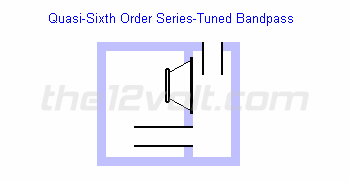
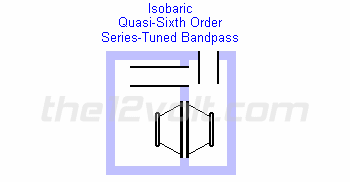
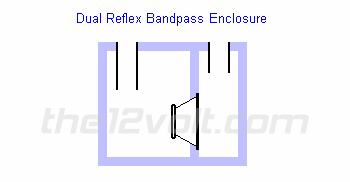

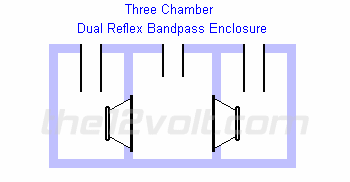
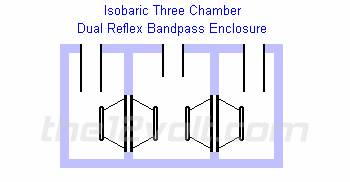
|
| |
Eigth Order Enclosures: Variations on a theme

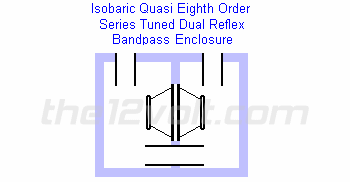
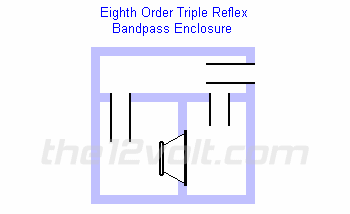
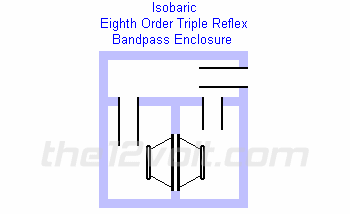
|

